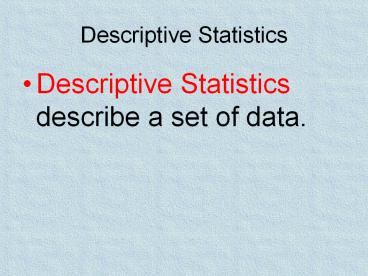Descriptive Statistics - PowerPoint PPT Presentation
1 / 30
Title:
Descriptive Statistics
Description:
Descriptive Statistics Descriptive Statistics describe a set of data. If I want to report findings from an observation or a survey, I may want to use a frequency ... – PowerPoint PPT presentation
Number of Views:93
Avg rating:3.0/5.0
Title: Descriptive Statistics
1
Descriptive Statistics
- Descriptive Statistics describe a set of data.
2
- If I want to report findings from an observation
or a survey, I may want to use a frequency
distribution. - A frequency distribution may be a simple chart, a
list, or a graph. - A graph of information always plots the frequency
along the y-axis, and the subject of the graph
along the x-axis.
3
Measures of Central Tendency
- Measures of central tendency provide statistics
that indicate the average or typical score in the
distribution. - Mean
- Median
- Mode
- There are three measures of central tendency
4
Mean
- The mean is the arithmetic average of all the
scores in the distribution. It is calculated by
adding all the scores in the distribution and
then dividing this sum by the number of scores.
5
Median
The median is in the middle of the road!
- The median is the middle score of the
distribution, the point that divides a
rank-ordered distribution into halves containing
an equal number of scores. Thus 50 of the scores
lie below the median and 50 lie above the
median.
6
Mode
- The mode is simply the score in the distribution
that occurs most frequently.
7
Graphing Measures of Central Tendency
- When graphing the mean, median and mode of a
distribution, roughly speaking, a distribution
has positive skew if the right tail is longer and
negative skew if the left tail is longer.
8
Positively Skewed
- This distribution has a positive skew. Note that
the mean is larger than the median.
9
- IE. In a neighborhood of relatively low incomes,
a few millionaires move in. Those few high
salaries will inflate the mean (average), but the
median will remain relatively low.
10
Negatively Skewed
- This distribution has a negative skew. The median
is larger than the mean.
11
- IE. In a particular well-to-do neighborhood, a
few low-income residents move in. The overall
average income will drop a bit, but the median
will remain relatively high.
12
Measures of Variability
- Measures of variability show how spread out the
distribution of scores is from the mean, or how
much dispersion or scatter exists in the
distribution. If there is a large degree of
dispersion, that is, if the scores are very
dissimilar, we say the distribution has a large
or high variability, or variance. If the scores
are very similar, there is a small degree of
dispersion and a small variance.
13
Measures of Variability
- Range
- Standard Deviation
14
Range
- The range is simply the numerical difference
between the highest and lowest scores in the
distribution.
15
Standard Deviation
- The measure of variability used most often in
research is the standard deviation, a statistic
that indicates the average distance of the scores
from the mean of the distribution.
16
- IE. Our class took Unit Exam 2.
- I scored a 76.
- How did I do compared to everyone else in class?
- I need to figure out what the class average was,
figure out the standard deviation from the mean,
and Ill know how well I did.
17
(No Transcript)
18
Standard Deviation
19
With a mean of 62 and a SD of 3, 95 of scores
should fall between what scores?
20
15.Which of the following sets of numbers has the
largest standard deviation? (a) 2, 1, 0, 1,
2 (b) 1.00, 1.25, 1.50, 1.75, 2.00, 2.25, 2.50,
2.75, 3.00 (c) 2, 6, 10, 14, 18 (d) 5.756, 5.765,
5.890, 5.895, 5.923 (e) 91, 92, 93, 94, 95
21
Graphing Standard Deviation
- Find the mean of your distribution set.
- Calculate the SD on your calculator.
- The mean is set at 0.
- 1 and -1 are your SD above and below the mean.
- IE. Your mean is 56 with a SD of 6. 1 would be
62, and -1 would be 50. - Calculate - 2 and - 3 in the same manner.
22
Graphing Standard Deviation
- What does this tell us?
- If the mean of a set of class scores on a unit
exam was 72, with a SD of 8, 68 of students
scored between a 64 and an 80. Your score of a
76 would be close to being better than 68 of the
rest of the class. - Approximately 95 of the class scored between a
56 and an 88. Your score of a 50 would indicated
that roughly 96 of the class did better than you
on the test.
23
(No Transcript)
24
Graphing Data
- Scatterplot A graphed cluster of dots that
represent the values of two variables.
25
- The SLOPE of the points suggests whether there is
a positive, negative, or non-existent
relationship between two variables.
26
- POSITIVE CORRELATION as one set of scores
increases, so does the other
27
- NEGATIVE CORRELATION as one set of scores goes
up, another set goes down
28
- NO CORRELATION
29
- No correlation relates to a score of 0.00
- A positive correlation ranges from 0.00 to 1.00
- A negative correlation ranges from 0.00 to -1.00
30
- How closely the dots are to each other along the
line indicates the strength or weakness of the
correlation as well

